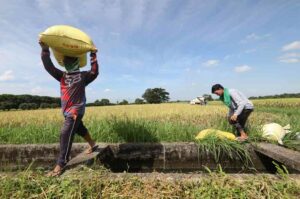THE Philippine Statistics Authority (PSA) said only 21.8% of the 19.68 million persons engaged in agriculture own or have rights to their farmland.
The 2022 Census of Agriculture and Fisheries (CAF) defines the agricultural population as individuals aged 18 and above that are members of households with at least one person engaged in agriculture.
Out of the total population, 10.13 million or 51.5% are males, while 9.55 million or 48.5% are females.
Some 4.3 million persons told the census that they own their land or have rights to farm it.
The Cordillera Administrative Region (CAR) posted the highest rate of farmland ownership or rights with 28.6%.
“This reflects the region’s strong emphasis on land ownership, which aligns with cultural and historical practices,” the PSA said.
Rounding out the list of leading regions were the Cagayan Valley (26.6%), Soccsksargen (25.69%), Central Luzon (25.68%), the Davao Region (25.4%), Bangsamoro Autonomous Region in Muslim Mindanao (25.1%), the Central Visayas (23.3%), Northern Mindanao (22.7%), and the Zamboanga Peninsula (22.2%).
Towards the bottom of the table were the Bicol Region (16.8%) Eastern Visayas (17.6%) and Western Visayas (18.2%).
“At the provincial level, Bohol, home to the highest number of farms in 2022, also led in the agricultural population with ownership or secure rights, totaling 191,867 individuals,” the PSA said.
“Isabela ranked second with 153,409 individuals, closely followed by Pangasinan with 149,863 individuals,” it added.
The census revealed that only 1.97 million of the agricultural population held formal title of ownership.
This was highest in Isabela (103,269), Bohol (81,236), and Pangasinan (72,449).
Meanwhile, 1.52 million individuals said they have owner-like possession over agricultural land with the leading provinces listed as Bohol (90,727), Negros Oriental (71,678), and Camarines Sur (50,406).
FISHERIESIn a separate report, PSA said that the number of fishing operators increased to 830,954 in 2022, up 9.3% from 760,297 in 2012.
The census also revealed 7.3% growth in the number of fishing operators to 853,065 from 795,070 10 years prior.
However, the average number of fishing operators dropped to 1.03% in 2022, down 1.8% from 2012.
“This suggests that fishing is becoming more of a household activity with fewer members per household actively engaged as operators, potentially due to diversification or transition of livelwihoods or a decrease in younger generations engaged in fishing,” PSA said.
The census recorded 854,587 engaged in capture fishing operations.
“Single proprietorship dominated the industry, accounting for 843,469 operations, or 98.7% of the total. Partnerships made up only 1.3% of fishing operations,” PSA said.
“Institutional involvement, such as corporations, cooperatives, and government agencies, was minimal, collectively contributing only 0.03%,” it added. — Justine Irish D. Tabile

